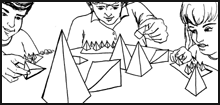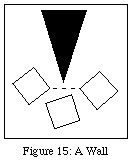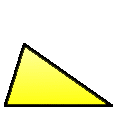 |
|
|
ICEHOUSE RULES GLOSSARY
 |
|
|
Air Lift: To place a piece on the field using primarily vertical motion, as in, "Let's see if I can air lift this one-pointer into that cozy little fortress."
Attack Piece: A piece that is lying on its side rather than standing up. As such it is usually pointing at, that is, attacking, a defensive piece.
Cheeseball: The strategy of building a self contained fortress away from the center of the playing area, against the edge of the table or the stash pad. Widely regarded as Uncool.
Crash Trap: A space on the field that appears to big big enough to hold a piece, but, most often, is not. Any player trying to place a piece into the space will most likely crash. Some crash traps arise naturally from play, but others are created puposefully to try and get more prisoners into the game.
Crash: Any action that noticeably alters the existing form of the playing area.
Defensive Piece: A piece that is played standing up rather than lying down. Such a piece is open to attack. Also called a standing piece.
Floss Call: There are some situations in which it it's difficult to figure out which piece a given attack piece is pointed at. In tourmaments, judges will usually have a piece of thread with them that they can hold over a game in progess, to make an official determination. That's what a Floss Call is.
Free Standing Piece: Any defensive piece which is not iced.
Ice Fortress: A structure on the playing field in which a defensive piece is surrounded by other pieces such that all attacks are blocked.
Iced Piece: A Defensive Piece which has been defeated in an attack. That is, there are more points worth of successful attack pieces being brought to bear on the defensive piece than that piece is worth.
Icehouse: The word a player speaks when he believes another player is below his stash limit and has no un-iced defensive pieces.
Meltdown: Failure to play 2 defensive pieces before playing any attack pieces.
Over-Iced Piece: An iced defensive piece that has so much attack force brought to bear upon it that an attack piece can be removed from the structure and still leave the defensive piece iced.
Pawn: A one-pointer.
Prisoner: A pyramid belonging to an opponent which for any of several reasons you have captured and added to your stash.
Signature: A player's Icehouse signature is the way in which they arrange their pieces on their stash pad prior to play. Different people have different styles.
Snowball: It the beginning of the game, many players place their initial defensive pieces in a group in the middle of the table. The adoption of the Snowball had a great effect on game play, moving most of the game to a central cluster. If you watch a game develop around a Snowball opening, you can really see the true meaning of the term. The opposite of Cheeseball.
Squandered Attack: An attack which fails to ice a defensive piece.
Stash Limit: The minimum number of pieces you must have
in your stash in order to be safe from an Icehouse call. (Usually
8.)
Stash Pad: The zone in which a player's unplayed pieces are stored.
Stash: A player's supply of unplayed pieces.
Victim: A defending piece which is under attack.
Wall: A theoretical barrier that attack pieces must breech in order to be successful. A wall is a line described by the shortest distance between 2 pieces, across an open space. If this line separates an attack piece from its target, then the attack piece must cross this line in order for an attack to succeed. See Figure 15. (The rules for Walls were dropped from the rules for Icehouse long ago, but some veteran players may still use them.)
 |
 |
 |